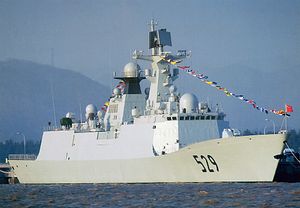Russia and China concluded their first-ever joint naval exercise in the Mediterranean Sea this morning, Sputnik News reports.
The naval drill code-named “Joint Sea 2015” was held from May 17 to 21 and involved nine ships from both countries.
On the Russian side, ships participating in the exercise were the Moskva, the leadship of the Atlant-class of guided missile cruisers, the Burevestnik-class frigate Ladny, the Bora-class hoverborne guided missile corvette Samum, the Ropucha-class landing ship Alexander Shabalin (designed for beach landings and capable of carrying a 450-ton cargo), and an older ship of the same class, the Alexander Otrakovsky, as well as a MB-31 tugboat.
On the Chinese side, the vessels involved were fewer in number but consisted of newer models including two Type 054A frigates, the Linyi and Weifang. Type 054A frigates are multirole warships and have been deployed for anti-piracy operations in the Gulf of Aden since 2009. Also, among other tasks, in January 2014, a ship of the same class was sent to escort Syrian chemical weapons destined for destruction. The People’s Liberation Army Navy (PLAN) currently has 18 Type 054A frigates in service. The third Chinese vessel to participate in Joint Sea 2015 was the Type 903 replenishment ship Weishanhu.
According to Interfax, the navies practiced underway replenishment and escort operations. Russian Ministry of Defense spokesman for the Navy Captain 1st Class Igor Dygalo told Interfax that, “the combined naval group of Russia and China practiced underway replenishment, cargo transfer and escorting missions during the daylight period of May 19.”
“Russian Navy and the Navy of the People’s Liberation Army of China ships held a joint practice of maritime escorts today, in a drill episode simulating the protection of safe shipping in remote areas of the World Ocean,” he added.
Additionally, yesterday night the two navies practiced “troop control by use of lighted aids,” Dygalo said. The Chinese media also noted that both sides practiced maritime defense including live-fire exercises.
“Naval forces of both countries made concerted efforts to explore new formats of joint exercises, and learn valuable experience from each other, which has made the drills a success,” said Du Jingchen, deputy commander of the Navy of the People’s Liberation Army of China and the Chinese task force commander.
The Russian Navy’s deputy commander, Vice Admiral Alexander Fedotenkov, told reporters that the joint-task force accomplished their assignments with “excellent” marks.
“The exercises, held far away from the Russian and Chinese naval bases, showed our readiness to jointly face new threats and challenges at sea, and the ability to safeguard stability practically in any area of the World Ocean,” he said.
Navy Commander Adm. Viktor Chirkov stated in a telegram that he is confident “that Russian-Chinese naval cooperation will continue to promote peace and stability.”
Both navies are currently conducting an after action review, according to Fedotenkov. What are the reasons for the exercise? For one thing, it fits with both nations’ desire to be perceived as global naval powers. The naval drill also signals to the West that the Mediterranean is no longer NATO’s Mare Nostrum as it has been the case for most of the 1990s and early 2000s.
Of course, there are also more practical reasons. “In material terms, the Russian and Chinese navies need to bolster their equipment ‘interoperability’ — their capacity to back up the Sino-Russian partnership’s policies efficiently and effectively,” Jim Holmes emphasized over at Foreign Policy.
Another explanation is China’s growing interest in Africa and the Middle East. Over at USNI News, an analyst also notes that “the Mediterranean constitutes the western end of the ‘New Silk Road,’ the Chinese project to link China with markets and producers across Central Asia and into Europe and the Middle East.” Consequently, this will certainly not have been the last Chinese naval presence in the region.

































